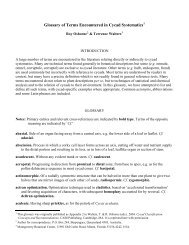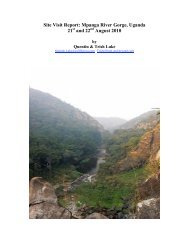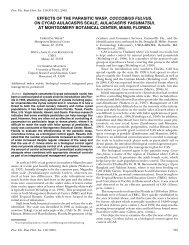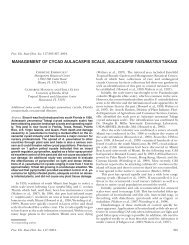Cycas-circinalis-cas.. - Cycad Specialist Group
Cycas-circinalis-cas.. - Cycad Specialist Group
Cycas-circinalis-cas.. - Cycad Specialist Group
You also want an ePaper? Increase the reach of your titles
YUMPU automatically turns print PDFs into web optimized ePapers that Google loves.
There was a very strong positive correlation between number of leaf scars and C.<br />
<strong>circinalis</strong> height (Fig. 7). This allowed us to estimate cycad age based on their height.<br />
Given that each individual produces two whorls of leaves per year, the height class<br />
categories in Fig. 4 can be converted to approximate ages, illustrated in Table 5.<br />
Fig. 7. Relationship between height and number of leaf scars for C. <strong>circinalis</strong>.<br />
N=34, p < 0.001<br />
No. of leaf scars<br />
350<br />
300<br />
250<br />
200<br />
150<br />
100<br />
50<br />
0<br />
y = 0.7832x - 5.9523<br />
R 2 = 0.9505<br />
0 100 200 300 400<br />
Height (cm)<br />
Table 5. Conversion of height classes to age classes based on estimates from<br />
number of leaf scars.<br />
Height class category (cm) Estimated Age Class (years)<br />
Seedlings (no stem)<br />
< 50 (non reproductive) 75<br />
These results suggest that cycads of about 15 years old and more are heavily<br />
harvested for their leaves. The data also indicate that C. <strong>circinalis</strong> individuals begin to<br />
reproduce at approximately 17 years of age. The biggest individual found measured 330<br />
cm high, and is estimated to be 146 years old.<br />
19






